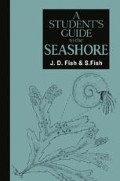Abstract
Although the majority of lichens are terrestrial, some grow in areas subject to salt spray and are a conspicuous feature of the upper reaches of many rocky shores. Some species are able to withstand daily submersion by the tide and are found in the eulittoral zone where they compete for space with other organisms, for example, barnacles and seaweeds. Lichens are complex plants comprised of fungal and algal components existing in what is believed to be a mutually beneficial association known as symbiosis. The exact nature of the relationship is still debated, but photosynthesis of the algal cells provides the fungus with organic nutrients, while the fungus provides the alga with support and protection.
Access this chapter
Tax calculation will be finalised at checkout
Purchases are for personal use only
Preview
Unable to display preview. Download preview PDF.
References
Alvin, K.L. 1977. The Observer’s book of lichens. London: Frederick Warne.
Dobson, F.S. 1981. Lichens. An illustrated guide. (2nd revised edition). Richmond: Richmond Publishing.
Duncan, U.K. 1970. Introduction to British lichens. Arbroath: T. Bunde.
Fletcher, A. 1975. Key for the identification of British marine and maritime lichens. I. Siliceous rocky shore species. Lichenologist 7, 1–52.
Fletcher, A. 1975. Key for the identification of British marine and maritime lichens. II. Calcareous and terricolous species. Lichenologist 7, 73–115.
Boney, A.D. 1961. A note on the intertidal lichen Lichina pygmaea Ag. Journal of the Marine Biological Association of the United Kingdom 41 123–6.
Fletcher, A. 1973. The ecology of marine (littoral) lichens on some rocky shores of Anglesey. Lichenologist 5 368–400.
Fletcher, A. 1973. The ecology of maritime (supralittoral) lichens on some rocky shores of Anglesey. Lichenologist 5 401–22.
Hale, M.E. 1983. The biology of lichens 3rd. edn. London: Edward Arnold.
Author information
Authors and Affiliations
Rights and permissions
Copyright information
© 1989 J.D. Fish & S. Fish
About this chapter
Cite this chapter
Fish, J.D., Fish, S. (1989). Lichenes. In: A Student’s Guide to the Seashore. Springer, Dordrecht. https://doi.org/10.1007/978-94-011-5888-6_5
Download citation
DOI: https://doi.org/10.1007/978-94-011-5888-6_5
Publisher Name: Springer, Dordrecht
Print ISBN: 978-0-04-574044-4
Online ISBN: 978-94-011-5888-6
eBook Packages: Springer Book Archive

